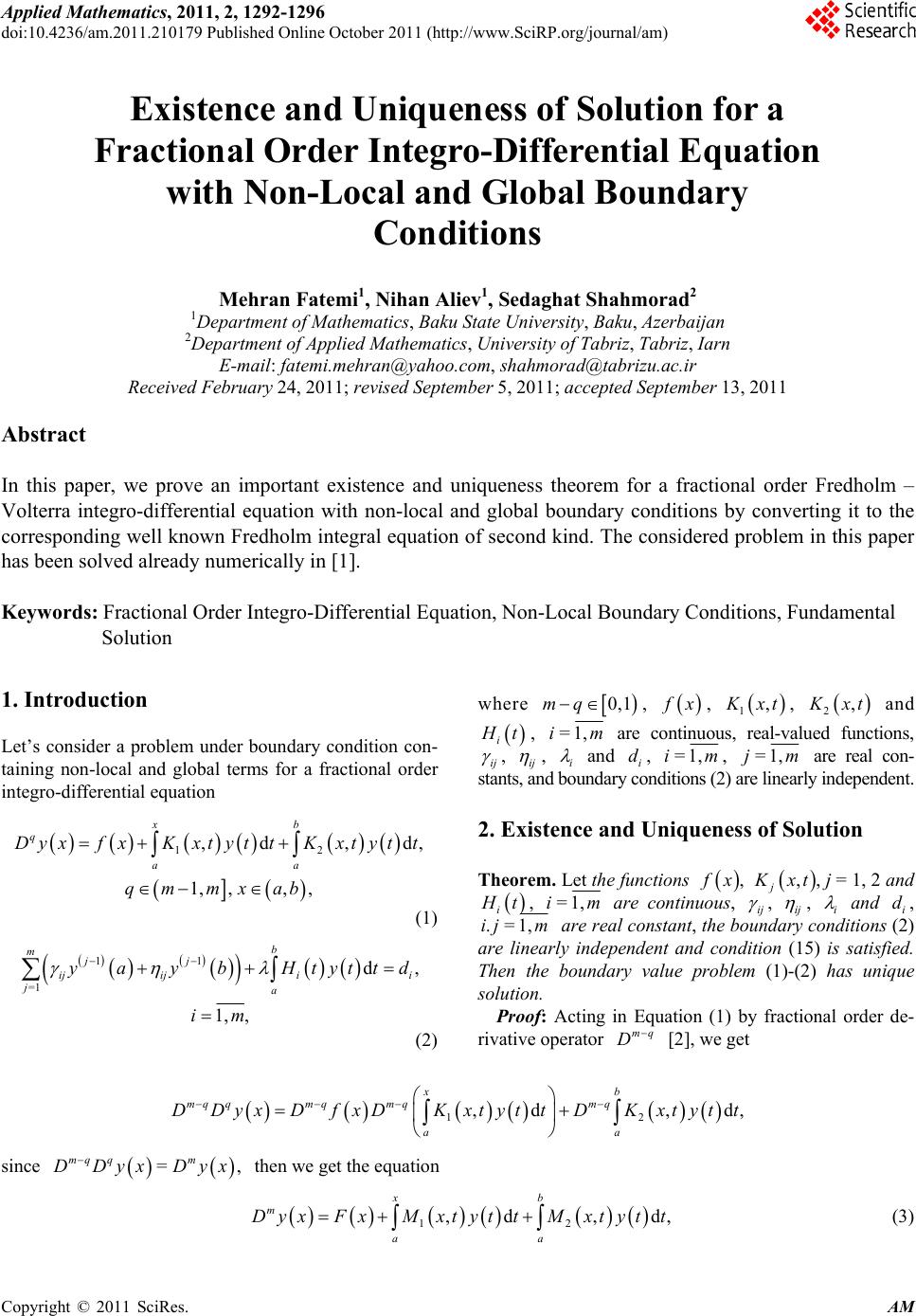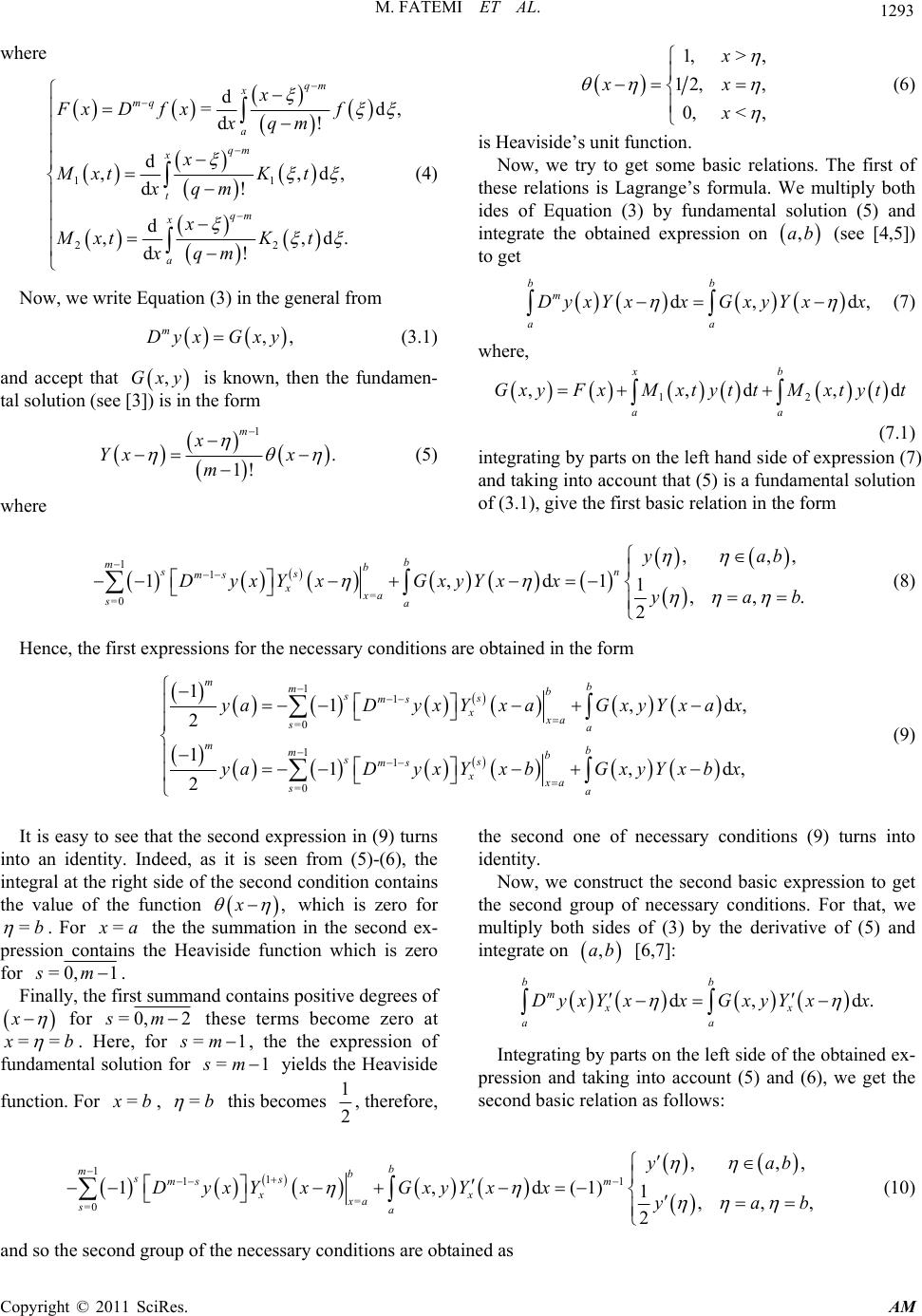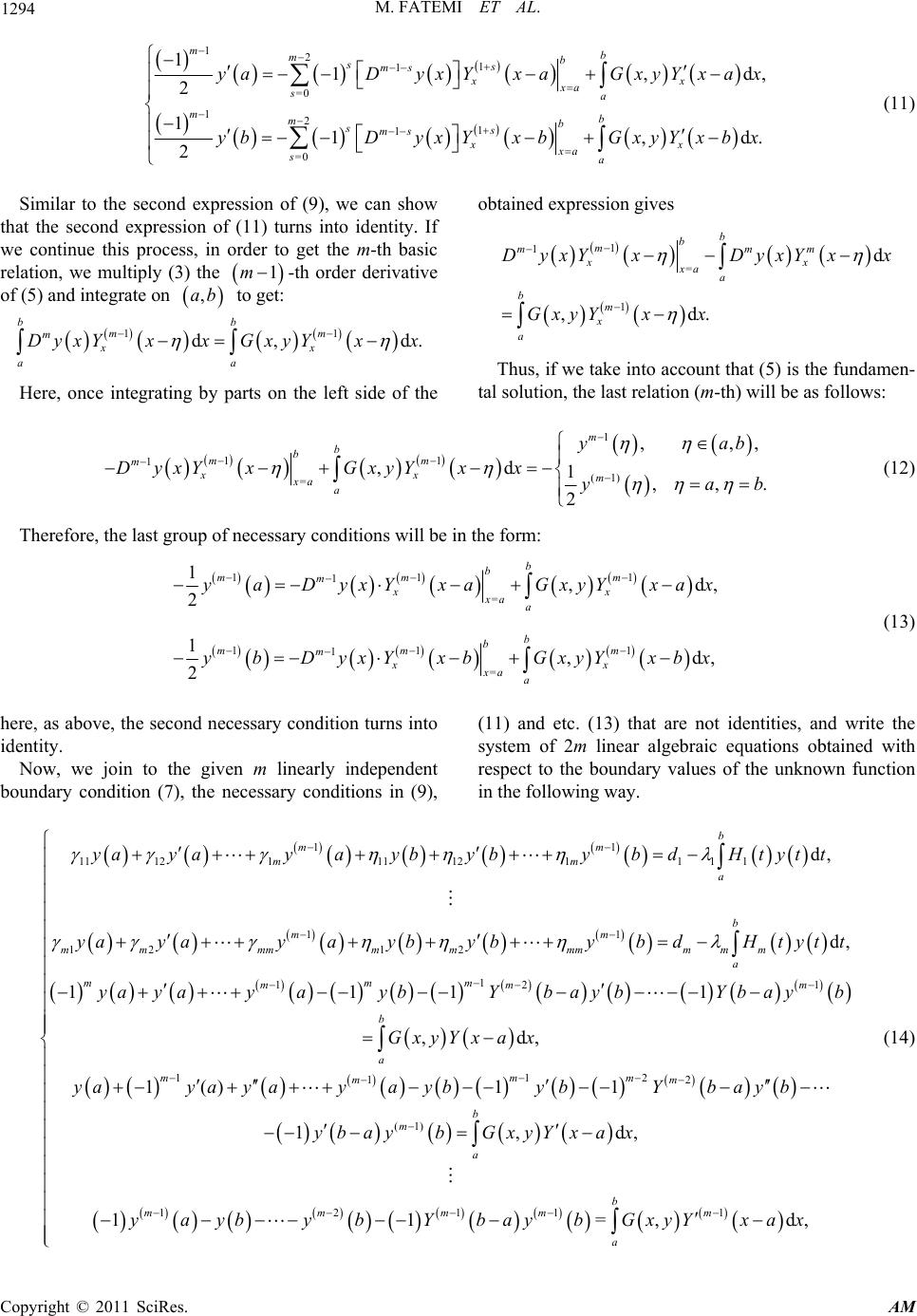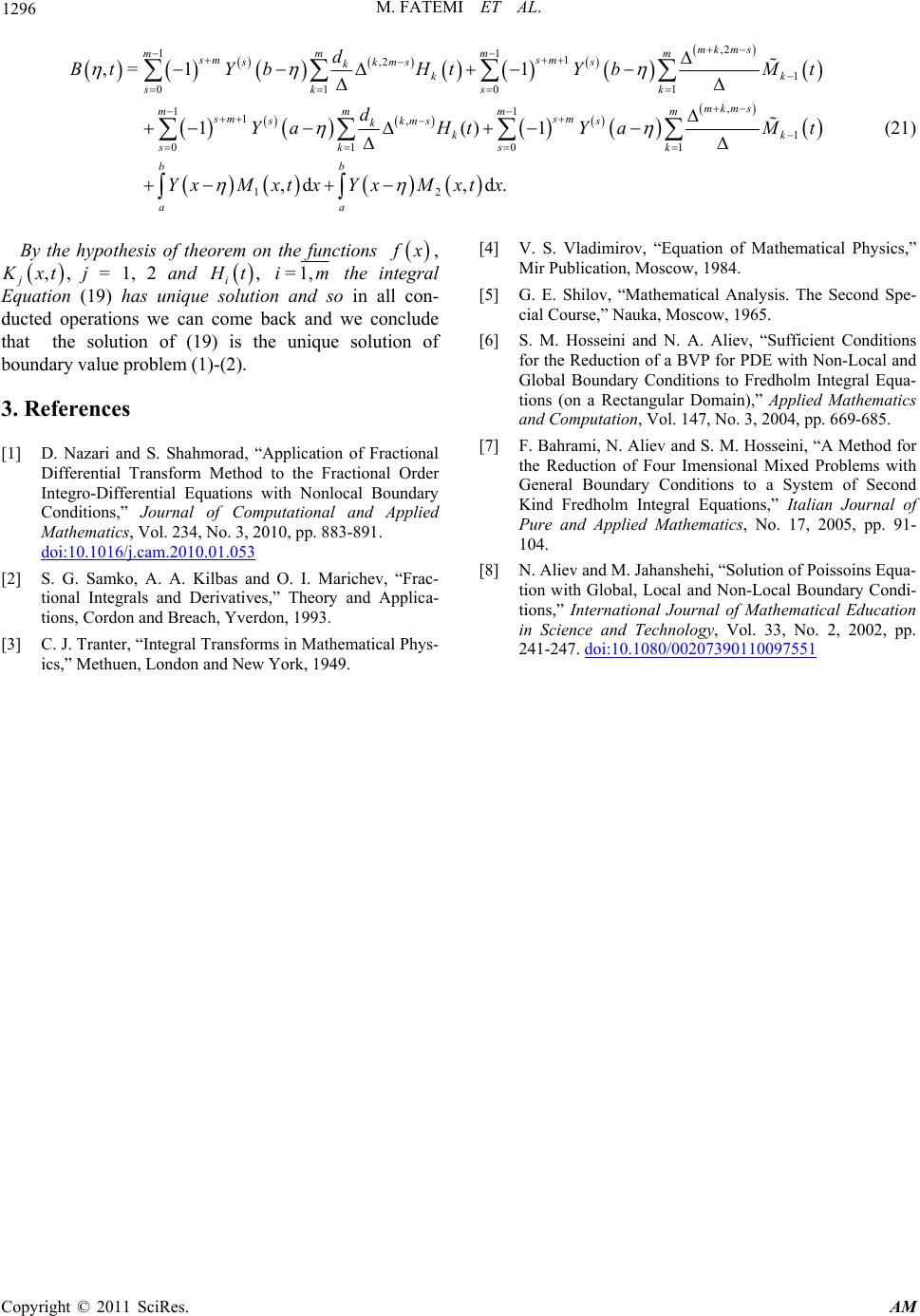 Applied Mathematics, 2011, 2, 1292-1296 doi:10.4236/am.2011.210179 Published Online October 2011 (http://www.SciRP.org/journal/am) Copyright © 2011 SciRes. AM Existence and Uniqueness of Solution for a Fractional Order Integro-Differential Equation with Non-Local and Global Boundary Conditions Mehran Fatemi1, Nihan Aliev1, Sedaghat Shahmorad2 1Department of Mat hem at i cs, Baku State University, Baku, Azerbaijan 2Department of Applied Mathematics, University of Tabriz, Tabriz, Iarn E-mail: fatemi.mehran@yahoo.com, shahmorad@tabrizu.ac.ir Received February 24 , 20 1 1; r evised September 5, 2011; accept e d September 13, 2011 Abstract In this paper, we prove an important existence and uniqueness theorem for a fractional order Fredholm – Volterra integro-differential equation with non-local and global boundary conditions by converting it to the corresponding well known Fredholm integral equation of second kind. The considered problem in this paper has been solved already numerically in [1]. Keywords: Fractional Order Integro-Differential Equation, Non-Local Boundary Conditions, Fundamental Solution 1. Introduction Let’s consider a problem under boundary condition con- taining non-local and global terms for a fractional order integro-differential eq uation 12 ,d ,d 1,,, , xb q aa DyxfxKxt yttKxt ytt qm mxab , (1) 11 =1 d, 1, , b mjj ij ijii ja ya ybHtyttd im where 0,1mq , x, 1, xt , 2, xt and i t, =1,im are continuous, real-valued functions, ij , ij , i and i, d=1,im, =1,jm are real con- stants, and boundary conditions (2) are linearly independent. 2. Existence and Uniqueness of Solution Theorem. Let the functions x, , j xt, j = 1, 2 and i t, =1,im are continuous, ij , ij , i and i d, .=1ij (2) ,m are real constant, the boundary conditions (2) are linearly independent and condition (15) is satisfied. Then the boundary value problem (1)-(2) has unique solution. Proof: Acting in Equation (1) by fractional order de- rivative operator mq D [2], we get 12 ,d ,d xb mq qmqmqmq aa DDyxD fxDKxtytt DKxtytt , , d, since then we get the equation = mq qm DDyxDyx 12 ,d , xb m aa Dy xFxMxtyttMxtytt (3)  M. FATEMI ET AL. Copyright © 2011 SciRes. AM 1293 where 11 22 d =d d! d ,, d! d ,, d! qm x mq a qm x t qm x a x Fx D fxf xqm x MxtK t xqm x MxtKt xqm , d, d. (4) Now, we write Equation (3) in the general from , m DyxGxy, (3.1) and accept that is known, then the fundamen- tal solution (see [3]) is in the form ,Gxy 1 . 1! m x Yx x m (5) where 1,> , 12, , 0,< , x x x x d,x d (6) is Heaviside’s unit function. Now, we try to get some basic relations. The first of these relations is Lagrange’s formula. We multiply both ides of Equation (3) by fundamental solution (5) and integrate the obtained expression on (see [4,5]) to get ,ab d, bb m aa DyxYxxGxyYx (7) where, 12 ,,d, xb aa GxyF xMxt yttMxtytt (7.1) integrating by parts on the left hand side of expression (7) and taking into account that (5) is a fundamental solution of (3.1), give the first basic relation in the form 11 = =0 ,, 1,d1 1,, 2 b mb s n s ms xxa sa ya DyxYxGxyYx xya , . b b (8) Hence, the first expressions for the necessary conditions are obtained in the form 11 =0 11 =0 11, 2 11, 2 mb mb ss ms xxa sa mb mb ss ms xxa sa yaDyxY xaGxyYxax yaDyxY xbGxyYxbx d, d, (9) It is easy to see that the second expression in (9) turns into an identity. Indeed, as it is seen from (5)-(6), the integral at the right side of the second condition contains the value of the function ,x which is zero for =b . For = a the the summation in the second ex- pression contains the Heaviside function which is zero for =0, 1ms . Finally, the first summand contains positive degrees of x for =0, 2sm these terms become zero at == b . Here, for =sm1 , the the expression of fundamental solution for yields the Heaviside =sm1 function. For = b, =b this becomes 1 2, therefore, the second one of necessary conditions (9) turns into identity. Now, we construct the second basic expression to get the second group of necessary conditions. For that, we multiply both sides of (3) by the derivative of (5) and integrate on ,ab [6,7]: d, bb mxx aa DyxYxxGxyYxx d. Integrating by parts on the left side of the obtained ex- pression and taking into account (5) and (6), we get the second basic relation as follows: 11 1 1 = =0 ,, 1,d(1) 1,, 2 b mb ss ms m xx xa sa , , ab DyxY xGxyYxx ab (10) and so the second group of the necessary conditions are obtained as  1294 M. FATEMI ET AL. 121 1 =0 121 1 =0 11, 2 11, 2 mb mb ss ms xx xa sa mb mb ss ms xx xa sa yaD yxYxaGxyYxax y bDyxYxbGxyYxbx d, d. (11) Similar to the second expression of (9), we can show that the second expression of (11) turns into identity. If we continue this process, in order to get the m-th basic relation, we multiply (3) the 1m bb -th order derivative of (5) and integrate on to get: ,ab 11 d, mm mxx aa DyxYxxGxyYxx d. Here, once integrating by parts on the left side of the obtained expression gives 1 1 = 1 d ,d. b b m mm xx xa a bm x a DyxY xDyxYxx GxyY xx m Thus, if we take into account that (5) is the fund amen- tal solution, the last relation (m-th) will be as follows: 1 11 1 (1) = ,, ,d 1,, 2 m b b mm mxx m xa a ya DyxY xGxyY xxya , . b b (12) Therefore, the last group of necessary conditions will be in the form: 11 1 1 = 111 1 = 1,d 2 1,d 2 b b mm m mxx xa a b b mm m mxx xa a yaDyxYxaGxyY xax ybDyxY xbGxyY xbx , , 1 m d, (13) here, as above, the second necessary condition turns in to identity. Now, we join to the given m linearly independent boundary condition (7), the necessary conditions in (9), (11) and etc. (13) that are not identities, and write the system of 2m linear algebraic equations obtained with respect to the boundary values of the unknown function in the following way. 11 11121111211 1 1 11 12 12 1 12 d, d, 1111 ,d, b mm mm a b mm mmmmmmmmm mm a mmm mm b a yaya yaybybybdHtytt yayayaybybybdHtytt yay ayaybYbay bYbayb GxyY xax ya 112 12 (1) 12111 1()1 1 1,d, 11=, mmm mm b m a b mmmmm a yay ayaybybYb ay b y baybGxyYxax yaybybYbaybGxyYxax (14) Copyright © 2011 SciRes. AM  M. FATEMI ET AL. 1295 For solving the system (14) by the Cramer’s rule, it is necessary that its basic determinant differ from zero. Accept that the following condition is satisfied 11 12111121 1212 12 1 0, 100 111 ... 00 (1)001 m m m mmmmmmm mmm m m Yba ba Yba (15) Then, from system (14), we g et 1,1 =1 =1 1,1 =1 =1 11 d,d 11 d,d bb mm ksks sss ss aa bb mm ksmks sss ss aa yad HtyttGxyYxax ybd HtyttGxyYxax , , , , msk msmk (16) where (,) q denotes the cofactor of the elements at the intersection of p-th row and q-th column of the determi-nant . Calculate the following expression: () 12 12 12 ,d ,d,d() dd,dd, dd ,dd, bbxb s s aaaa bbxbb ss s aaaaa bbbbb ss s aaa aa GxyYxaxF xMxtyttMxt yttYxadx d d. xYxaxY xaxMxtyttYxaxMxtytt xYx axyttYxaMxtxyttYx aMxtx Then, we get: ,d bb sss aa GxyYx axFMtytt d, (17) and so, 21 d, ,d ,d, bs sa bb ss saa FFxYxax tYxaMxtxYxaMxt x d,t (18) Finally, coming back to (8), we take into account (16) and (17) and write the second kind Fredholm type inte-gral equation [8] for which the boundary value problem (1)-(2) is reduced to: , b a yA Btyt (19) where ,2 11 11 ,2 1 0101 , 11 1,1 0101 11 11 mk ms mmmm sm sm skms s kk sksk mkms b mmmm sm sm skmss kk sksk a d AYbYb F d YaYaF FxYx x d, (20) Copyright © 2011 SciRes. AM  1296 M. FATEMI ET AL. ,2 11 1 ,2 1 01 01 , 11 1,1 0101 12 ,= 11 1()1 ,d ,d. mk ms mmm m sm sm skms s kkk sk sk mkms mmmm sm sm skms s kkk sksk bb aa d Bt YbHtYbMt d YaHt YaMt Yx MxtxYxMxtx (21) By the hypothesis of theorem on the functions x, , j xt , j = 1, 2 and i t, =1,im the integral Equation (19) has unique solution and so in all con- ducted operations we can come back and we conclude that the solution of (19) is the unique solution of boundary value problem (1)-(2). 3. References [1] D. Nazari and S. Shahmorad, “Application of Fractional Differential Transform Method to the Fractional Order Integro-Differential Equations with Nonlocal Boundary Conditions,” Journal of Computational and Applied Mathematics, Vol. 234, No. 3, 2010, pp. 883-891. doi:10.1016/j.cam.2010.01.053 [2] S. G. Samko, A. A. Kilbas and O. I. Marichev, “Frac- tional Integrals and Derivatives,” Theory and Applica- tions, Cordon and Breach, Yverdon, 1993. [3] C. J. Tranter, “Integral Transforms in Mathematical Phys- ics,” Methuen, London and New York, 1949. [4] V. S. Vladimirov, “Equation of Mathematical Physics,” Mir Publication, Moscow, 1984. [5] G. E. Shilov, “Mathematical Analysis. The Second Spe- cial Course,” Nauka, Moscow, 1965. [6] S. M. Hosseini and N. A. Aliev, “Sufficient Conditions for the Reduction of a BVP for PDE with Non-Local and Global Boundary Conditions to Fredholm Integral Equa- tions (on a Rectangular Domain),” Applied Mathematics and Computation, Vol. 147, No. 3, 2004, pp. 669-685. [7] F. Bahrami, N. Aliev and S. M. Hosseini, “A Method for the Reduction of Four Imensional Mixed Problems with General Boundary Conditions to a System of Second Kind Fredholm Integral Equations,” Italian Journal of Pure and Applied Mathematics, No. 17, 2005, pp. 91- 104. [8] N. Aliev and M. Jahanshehi, “Solution of Poissoins Equa- tion with Global, Local and Non-Local Boundary Condi- tions,” International Journal of Mathematical Education in Science and Technology, Vol. 33, No. 2, 2002, pp. 241-247. doi:10.1080/00207390110097551 Copyright © 2011 SciRes. AM
|